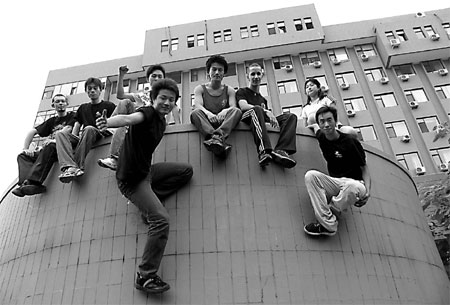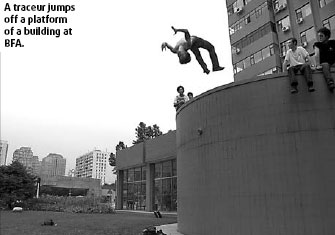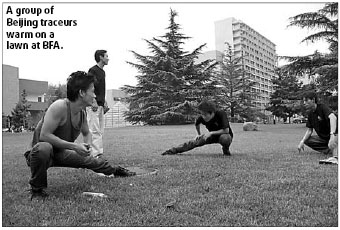No capes required
 |
|
Du Yize (fourth from right), Alejandro Gil Mateos (third from right), Larry (first from right), Li Zheng (fourth from left) and other four Parkour enthusiasts at the Beijing Film Academy. Photos by Zhang Yongzhong |
Du and his friends land on the lawn together, each making different poses in the air.
Their landings are perfect, and one of the teenagers rolls and then makes a "V" for Victory hand sign to a crowd of curious onlookers. The crowd erupts with wild applause.
Du and his friends are not making an action movie - they are practicing Parkour, a French style of street sport, which involves running, climbing and bouncing off buildings.

It was recently made famous in the opening scene of the new James Bond movie Casino Royale. But it has been in France for more than 20 years. Parkour is generally practiced in cities and the aim is to move from point A to point B as efficiently and quickly as possible, using hands, arms, legs and feet. The obstacles could be anything in the environment, ranging from branches and rocks to concrete walls and roofs.
On the surface, Parkour is similar to martial arts. However, martial arts are a form of training for the fight, Parkour is a form of training for flight.
Zhou Hong, who is known as Larry among friends, first learnt about Parkour when chatting with his foreign friends on the Internet.
The Sichuan native soon became interested during his researches and he even found some online video clippings of the sport.
In order to find others interested in Parkour, the 21-year-old launched www.paoku.com.cn - China's first such website in Beijing.

The number of registered members, whose ages range from 16 to 25, now stands at more than 5,200 throughout the country.
Parkour requires very little money, and moreover, traceurs are allowed to dress casually.
At the beginning, residential parks were ideal training places until misunderstandings began to occur.
One member, whose nickname is Wang Ling on the Internet, once practiced free running in his community park.
But he was mistaken for a thief and was chased by four local security guards. Finally the poor man climbed up some wire netting and tried to explain.
Few people know of the sport in China, Wang says. Therefore, they think the practitioners are nuts and fooling around.
"What we should bear in mind is not to disturb local residents, not to destroy public facilities, and more importantly, warn children not to imitate our dangerous movements," he adds.
Currently they train at the Beijing Film Academy (BFA). Every Saturday, more than 10 traceurs gather there to practice from 9 am to 6 pm.
"You cannot improve if you just practice alone," Zhou comments,
"It is good to play with a team, where people can learn from each other, and be supportive as well."
Consulting various foreign visual programs via the Internet, Zhou and his teammates have selected more than 40 basic movements, including cat balance, turn vault, dismount and swinging through a gap between obstacles.
Du is perhaps the most talented of the group. The second year university student at BFA set a record of climbing up an 8-floor building in 1'12 minutes. The video of his remarkable feat is widespread on the Internet, and Du now wants to become Jackie Chan's successor.
The 22-year-old believes Chan is the originator of Parkour, as the star has performed a lot of Parkour-style movements in his movies. "Parkour absorbs many elements from other activities - kickboxing and street dancing for instance. However, I would prefer practicing Chinese-style Parkour by mixing Chinese marital arts with it," he says.
"The activity provides me an opportunity to show myself by using the body," Li Zheng says.
The Zhejiang native performs whenever he can, such as jumping off high steps at the entrance of a metro station. Attracting onlookers' attention, the 21-year-old feels like he's floating in the air.
"This feeling is what I really want. I think I live in Parkour," he says.
Foreign faces can also be seen in the team of Chinese traceurs. Alejandro Gil Mateos is one of them. Inspired by his former English classmate who is also a Parkour lover, the Spanish student at BFA used his limited Chinese to contact people at paoku.com.cn this year, and later joined the team.
"Parkour in Europe is more developed, while Chinese people are still learning it and copying a little bit from Europe," Alejandro comments.
"There is a gap between foreign traceurs and Chinese ones," Zhou admits. "Especially to a degree of facing obstacles, I am impressed by how they give 100 percent to perform the movement. For instance, they don't care if they roll over in mud, but we do!"
Alejandro says that Parkour has also had an influence on the way he thinks.
"Parkour people learn and practice to get over obstacles rather than to simply avoid them. It is not only for physical things, but also to train them to overcome obstacles in everyday life."
Romain Abeck, who just became a new member of the team, shares these sentiments.
"Parkour challenges your limits. To push them, you will get stronger not only in your body, but also in your mind," the 25-year-old French translator says.
But there are also risks and almost all Chinese traceurs have been injured at some stage.
"Hands and feet are wounded constantly, especially when we practice the movements of jumping through obstacles," Zhou says, rolling up his trouser legs to reveal a patchwork of scars.
Alejandro adds: "Everyone has his own development, and you have to see what the most you can do, then go little by little to improve yourself."
One marital arts insider surnamed Zhang, thinks the phenomenon of traceurs often getting injured shows that they have yet to master the key movements.
He says Parkour requires body conditioning and strong physical skills compared with slide or street dancing which are also popular among young people.
"It can be a satisfying experience, however, people should bear in mind the safety issues. Protective equipment is needed," he says.
(China Daily 08/29/2007 page20)














